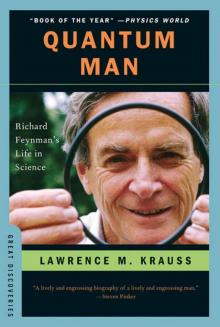- Home
- Lawrence M. Krauss
Beyond Star Trek Page 3
Beyond Star Trek Read online
Page 3
In practice, things are even worse than this “rocket equation” predicts, since a ship designed to carry a disproportionately large volume of fuel will doubtless have to be sturdier than it would otherwise have to be, and will therefore weigh more. It is generally impossible to carry enough fuel to move a ship faster than 3 or 4 times the velocity of the propellant.
It gets worse still. A round-trip voyage even to the nearest planets would be, at best, a multiyear proposition. You must therefore design a spacecraft that can adequately house, feed, and provide a breathable atmosphere for astronauts for an extended time period. Such a spacecraft would have to weigh substantially more than an Apollo capsule. Since the total amount of fuel required is a fixed multiple of the spacecraft weight, this means that the net fuel requirement for a mission to Mars would be many times that associated with a voyage to the Moon, even if faster speeds were not needed.
Then there’s the matter of getting back. Mars has a stronger gravitational field than does the Moon, so to achieve a trajectory back to Earth you would have to carry a comparable amount of propellant for the return trip, in order to build up a velocity, relative to Mars, comparable to the velocity one had to build up relative to the Earth to get to Mars in the first place. This means that the ratio of fuel required for the return journey, relative to the mass of the now lighter spacecraft, is similar to that required for the outbound journey.
However, if this fuel is brought along on the outbound journey, then it must be added to the initial mass of the spacecraft before you can calculate the initial fuel requirements. To get an idea of the problem, imagine that the fuel required to achieve a sufficient velocity is 5 times the mass of the spacecraft with an empty tank. If you need a comparable ratio to get up to speed on the return journey, then you would need to land on Mars with a spacecraft that weighed 6 times the mass of an empty spacecraft—that is, the mass of the empty spacecraft plus 5 times the mass of the spacecraft in fuel required for the return journey.
This would mean that the mass of the spacecraft plus fuel at takeoff from Earth would have to be 36 times the mass of the empty spacecraft! This accounts for the mass of spacecraft and the fuel for the return voyage, plus 5 times this total mass for the fuel required for the outbound voyage. I want to emphasize this point, since a somewhat similar estimate in my last book—associated with the mass of fuel required for the Enterprise to get to half light speed and then come to a stop—generated more mail than any other single item. The total amount of fuel needed is not 6 plus 6, or 12, times the mass of the empty spacecraft; it is 6 times 6, or 36. Pretty soon, to paraphrase former Lockheed/Martin rocket engineer Robert Zubrin, you end up with Battlestar Galactica! In light of this, perhaps the monstrous flying saucers in Independence Day were not all that unrealistic; they might have needed to be that big just to carry the necessary fuel!
The preceding scenario more or less governed what happened when NASA first officially considered a manned mission to Mars, in 1989. The price tag for the Monster Ship? Between $400 billion and $450 billion! At this cost, a human mission to Mars in our lifetime would remain a pipe dream—and this project pales in comparison to the requirements of getting beyond our solar system, out to other stars. Every aspect of such a mission would exacerbate the fuel problems I have mentioned.
The point is that our galaxy is really a big place. The distance even to the closest stars is many thousands of times greater than the distance across our solar system, and at currently achievable speeds, a trip to the closest star would take in excess of 10,000 years, one way! Even at speeds close to the speed of light, to fully explore even the nearest star systems for life would take many centuries. (This is why Ripley “hibernates” in the Alien movies.) And there are at least 100 billion stars in our galaxy alone, while the Milky Way is just one of over 100 billion galaxies in the observable universe.
At the very least, it is clear that to travel beyond our solar system on a human timescale, we would have to reach speeds much greater than are possible now. To appreciate the magnitude of the problem, let’s consider the onboard fuel requirements just to accelerate a spacecraft to 25 percent the speed of light, at which rate a one-way trip to Alpha Centauri would take a mere 10 years. (I will ignore here the fact that it would take at least a year to do the accelerating, if you want to survive that process.) If we make use of the rocket equation—which, I remind you, is an underestimate of the fuel requirements—and specify conventional rocket fuel, the fuel mass would be 1 followed by approximately 20,000 zeros times the payload mass! To deliver just a single atom to the nearest star would thus require more fuel than is available from all the matter known in the universe! I think even Congress would realize that this is not the way to go.
Conventional fuel is obviously the straw man in this conundrum, though. No one has seriously suggested trying to reach the stars with rockets of the type we use to orbit the Earth. But there is a lot of creative thinking going on in this business, so a number of people are claiming that at least a manned Mars mission in the next decade or two is a reasonable goal. From there, who knows? The exigencies of space travel require us (and any aliens out there who want to get here, however advanced their technology) to utilize two simple ideas, both of which, oddly, hark back to the prescient 1960s: Small Is Beautiful and Live Off the Land.
CHAPTER FOUR
A COSMIC GAME OF GOLF
SCULLY: Why is it so dark in here?
MULDER: Because the lights are out.
Whether you are Han Solo, Jean-Luc Picard, or some slimy alien, the most daunting challenge you face once you engage your thrusters is not how to zip around the sky with the ease of a hummingbird. It is to get moving in the first place.
Size isn’t important, some of us are often told, but as consoling as that might be in certain circumstances, it isn’t true when it comes to building spacecraft. Say you are stuck on some very slippery ice. The only way to get back to shore is to use propulsion. You could push yourself off a nearby rock very effectively. In this case, a lot of mass (the rock) moves away slowly when you push it, and you move away very fast. However, if you have to bring your own fuel with you, most people would not opt to carry a rock along for such a purpose. Instead, you might pack your backpack more lightly, with a golf club and golf balls. When you want to move on the ice, you unpack the balls, place them on the ice, and hit them away one at a time. Each ball you hit, being light, doesn’t cause you to recoil rapidly. But since you can propel each golf ball much faster than you can throw a heavy rock, and since what matters for the outgoing propellant is a combination of mass and velocity, by the time you’ve exhausted your supply of golf balls you may be moving much faster than you would have if you’d simply thrown a rock.
The process just described is counterintuitive—probably because most people (and I’m no exception) prefer instant gratification. But Aesop was right—slow and steady wins the race, if “slow and steady” refers to acceleration and the race is long enough. If achieving a greater final cruising speed is more important than reaching your cruising speed quickly—which is certainly the case for space travel, as opposed to (for example) the firing of ground-to-air missiles—what you need more of is not thrust, the quick acceleration you get from expelling a lot of fairly slow-moving material, but impulse, the large final velocity achieved by the steady release of small amounts of material that travel away very fast. (Given the rapid achievement of cruising velocity after Jean-Luc Picard engages the impulse drive aboard the Enterprise, it should probably be called the thrust drive.)
What are the existing and potential rocket-engine equivalents of “golf balls” currently under investigation by researchers? Clearly what is wanted are light projectiles and the energy to send them out very fast. The lightest atom in existence is hydrogen (1 proton plus 1 electron), so that’s the obvious projectile of choice, and essentially all existing proposals use it as the propellant. The source of energy to boost the propellant depends on available technology. The most
likely candidates in the short term are nuclear thermal rockets, currently being studied by a group at NASA’s Lewis Research Center, near where I live in Cleveland, Ohio. Here, a nuclear reactor simply heats a liquid—for example, liquid hydrogen—to as high a temperature as one safely can (about 2,500°C, given current materials) and then spurts the “steam” out the back end of the reactor. In this way, experimenters have achieved exhaust velocities as great as 10 kilometers per second, or 1/300 of a percent of the speed of light.
While this velocity may not sound useful as far as interstellar travel is concerned, it would be a boon to interplanetary travel. Using this technology, one might send a craft to Mars and back with only about 5 or 10 times the mass of the payload in fuel. The problem is that the nuclear-reactor technology required is large-scale and currently politically incorrect. However, if the political climate changes and the use of nuclear reactors in space becomes acceptable, a better option might be what is called a nuclear electric propulsion system. In this system, instead of using nuclear power to heat up gas as a propellant, one could use the nuclear reactor to generate heat which is then used to generate electricity, as we now do on Earth. One could then use large electric fields to accelerate atomic nuclei (such as the proton that forms the hydrogen nucleus), much as we now do in the large elementary-particle accelerators we’ve built to study the fundamental structure of matter. In the versions that have been explored, these charged particles would fly out the back of the engine at close to 50 kilometers per second. (Modern particle accelerators bring particles almost to the speed of light, but these devices are generally many miles long and at present require power sources much greater than would be available to a spacecraft.) In this way, one might build rockets for interplanetary travel which required only 2 to 4 times the mass of the payload in fuel, and, more important, one could build up speeds that allowed travel even to the outer planets in months instead of years.
None of these technologies, however, would help much for the near-light-speed travel required to reach the stars. If one wanted to achieve these speeds by internal propulsion, one would need a propellant that traveled at a significant fraction of the speed of light.
Enter Star Trek. The Enterprise’s impulse drive just referred to, used for sub-light-speed travel, is powered by nuclear fusion. This is precisely the method one would choose in the real world to approach the speed of light. When one combines, or “fuses,” hydrogen nuclei—or the nuclei of its heavy cousin, deuterium—to form helium, the energy released is sufficiently great that the helium nuclei receive kicks that propel them to about 5 percent of the speed of light. One can imagine, at least in principle, accelerating spacecraft to 3 or 4 times this value, with the fuel weighing less than 100 times the mass of the rest of the payload—a quantity that of course is still nothing to shake a stick at.
Even here, success breeds its own problems. The very reason that fusion is so effective—the great amount of energy released—also presents a concern. How do you ensure that all the energy gets out the back and doesn’t melt the engine—or the spacecraft, for that matter? Remember how much heat the saucers in Independence Day would have to generate! Of course, as we physicists like to say, this is an engineering problem—so let’s not worry about it now.
But there are other problems. If you want to stop as well as start, you have to bring along the fuel required to stop, which will be the same amount as was required to start. This means you need to bring not just nearly 100 times the mass of the rest of the payload in fuel, but 100 times the mass of both the payload plus fuel required to stop, or about 10,000 times the mass of the original payload. And that’s just to start and stop! It doesn’t include the fuel required for the return journey.
This might suggest that we should not fool around with any propellant that travels slower than the speed of light itself, if we want to head out at near light speed. So, in this case, why not just send out a beam of light behind you in order to accelerate? The problem here is that visible light carries with it an extraordinarily small amount of energy. Thus, while in principle one could eventually accelerate to light speed by shooting a laser beam out behind the ship, it would take an incredibly long time to do so.
Let’s get back to being stuck on the ice: Emitting visible light is analogous to throwing off grains of rice. This will eventually get you to shore, but it will take an awful lot of rice to start you moving. Accelerating and decelerating single atoms with visible light from lasers has been demonstrated in the laboratory, and it works very well. Unfortunately, we and our ships are made of an awful lot of single atoms.
We shouldn’t despair, however, because there is a way of producing radiation at a much higher energy than the type we normally produce with lasers. If we take a particle of matter and annihilate it with a particle of antimatter, the products can shoot out at near the speed of light, and, more important, they will carry away all the original energy of the matter-antimatter pair that were annihilated—just as if you had kicked out the original particles at something like the speed of light. This is a process tailor-made for rocket propulsion. As bomb makers like to say, there is no bigger bang for your buck.
Antimatter may sound like pure science fiction, and indeed it is central to Star Trek propulsion. But it isn’t science fiction at all. A brief review is in order: The existence of antimatter in nature is an inevitable consequence of the theory of relativity, combined with the laws of quantum mechanics governing the nature of subatomic particles, about which I shall have much to say later. Antiparticles are identical to their normal-particle partners in all respects—same mass, spin, and so on—but they have the opposite electric charge, and a few other, more obscure characteristics are reversed as well. When a particle and antiparticle interact, they may annihilate into pure radiation, which carries away the energy stored in their mass. By 1930 it was understood that antimatter should exist, and (coincidentally) within 2 years the antiparticle of the electron was discovered amid the cosmic ray particles that shower the Earth every day from outer space.
Now, the problem is that antimatter is generally hard to come by. Not much of it exists in the universe, although a discovery at the time of this writing suggests that there is a handy fountain of antimatter at the center of our galaxy, if only we could get there to tap into it. (The only practical way to get there to tap into it might be in light-speed ships powered by antimatter.) I described at great length in my last book how we actually produce charged particles of antimatter on Earth in our large particle accelerators. I now have a chance to update those discussions by describing several recent experimental discoveries. While I predicted at the time that such results would be produced in this decade, I was completely wrong about where they would occur.
The big news in 1996 was the production, for the first time, of neutral antiatoms at the CERN (European Center for Nuclear Research) laboratory in Geneva. Antiatoms are the experimental holy grail in antimatter research. The antiparticles we normally produce in our laboratories are the antiparticles of elementary particles—protons, say, or electrons—not the atoms composed of combinations of these particles. These electrically charged antiparticles are not particularly exotic, other than having the opposite charge of their particle partners. But atoms are electrically neutral (which is a good thing, because if they weren’t, the electric forces between each of us would be strong enough to crush us completely, or perhaps first cause each of us to explode).
There is a fundamental theorem in physics that if the universe were made of antimatter instead of matter, the antimatter would have combined to form antiatoms that would behave essentially like normal atoms. Antistars would look like normal stars—they would emit the same frequencies of light, and so forth—and antibaseballs would fall toward anti-Earth at the same rate as normal baseballs fall to Earth. Anti-Captain Kirks would not be evil, and anti-Mr. Spocks would not laugh or grow beards. The universe would look essentially the same. While we have no reason to doubt this based on every indir
ect test we have done to date, there is one direct test we have not yet performed. Until 1996, we had never observed antiprotons combine with antielectrons to make antiatoms. Until we had antiatoms, we could never do any experiments on them directly to see if they behave like normal stuff.
The first antiatoms created at CERN were produced in an exotic way. When very-high-energy particles collide with a thin target, all sorts of new particles are created, which stream out behind the target in the same direction as the original particle beam. If you take a very-high-energy beam of antiprotons (used at CERN to explore the fundamental structure of matter) and bombard a target with this beam, some of the new particles produced are positrons, the antiparticles of electrons. Very rarely, a positron may be kicked out behind the target with a velocity close to that of remnant antiprotons in the beam which find their way through the target. These positrons will travel alongside the antiprotons, and if you’re lucky, a positron and an antiproton will combine to form antihydrogen.
At the CERN accelerator, the antihydrogen atoms produced this way were traveling at close to the speed of light, and were disrupted within several millionths of a second. This time period was far too brief for accurate experiments to be done with these antiatoms. What one would like to do is produce antihydrogen at rest in the laboratory and keep it around for an appreciable length of time. One could then see, for example, whether or not antihydrogen atoms fell in the Earth’s gravitational field at exactly the same rate as hydrogen atoms. Or one could excite the antihydrogen atoms with an electric current to see whether or not they responded by emitting light with exactly the same frequencies that hydrogen does.

 Beyond Star Trek
Beyond Star Trek Hiding in the Mirror: The Quest for Alternate Realities, From Plato to String Theory (By Way of Alicein Wonderland, Einstein, and the Twilight Zone)
Hiding in the Mirror: The Quest for Alternate Realities, From Plato to String Theory (By Way of Alicein Wonderland, Einstein, and the Twilight Zone) The Greatest Story Ever Told—So Far
The Greatest Story Ever Told—So Far Quantum Man: Richard Feynman's Life in Science
Quantum Man: Richard Feynman's Life in Science